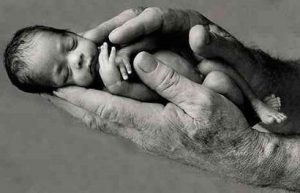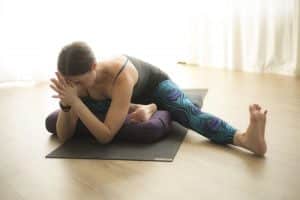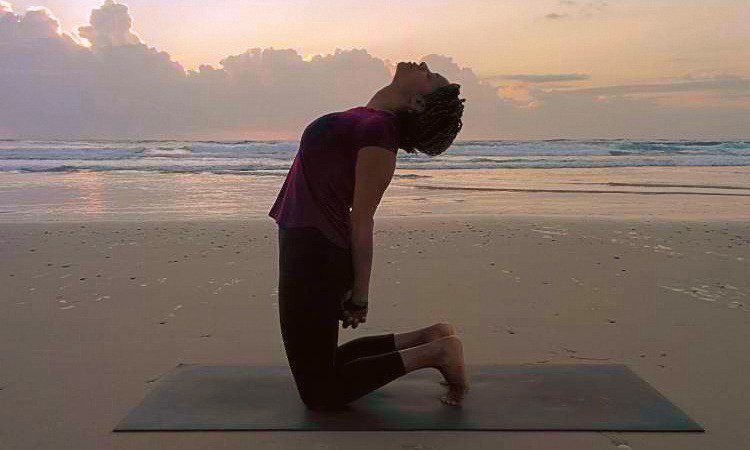How To Be Vulnerable In Your Yoga Practice
Article by Selly Kempton
http://www.yogajournal.com/article/yoga-101/protective-services/

“Learn to be vulnerable in your yoga practice rather than using your practice to mask emotion.”
Yoga, after all, is not an escape from life but a way of taking yourself into life’s pulsing heart. It will inevitably lead you to your own vulnerability, to your raw places. But vulnerability also opens the door to love, grace, and the deepest forms of healing. Your vulnerability, scary as it can be, is inseparable from your capacity for intimacy and creativity and love.
Here’s the caveat: The practice of opening to vulnerability is not for wimps. It’s an advanced practice, requiring strength, discernment, and boundaries—all qualities your yoga practice will give you, if you give it time.
Be Willing To Dig Deeper
The most open person I have ever met was my teacher, Swami Muktananda. When you looked into his eyes, you seemed to meet no barriers at all; he would meet you at the deepest place you were willing to go. At the same time, I’ve never met anyone with such strong boundaries and such a take-no-prisoners attitude toward challenging situations. He embodied the lines of the 17th-century poet-saint Tukaram Maharaj: “We servants of God are softer than butter, but we can cut diamond.” His softness, paradoxically, was made possible by his hardness. The energetic strength he had attained through yogic discipline and his skill at containing his energies and turning them inward had created a vessel of absolute protection.
The spiritual journey often looks like a dance between the two distinct poles of vulnerability and boundaries. It’s a continuing dialogue between the impulse to soften and open and the impulse to contain and protect. The two apparent opposites turn out to be equal partners in the process of embodying spirit and heart.
So the question is how do you protect yourself from the dangers of vulnerability without sacrificing its gifts? You begin by looking at the origins of vulnerability and understanding the path it typically takes.
Learn the Vulnerability of a Child
The developmental journey of every human being begins in utter vulnerability. If you’re lucky enough to have caring parents, your original vulnerability is met with kindness, and as a result you develop a basic trust in the goodness of the universe. But even when you have great caregivers, infancy and early childhood are filled with inevitable losses—your mother’s temporary absence, weaning, the birth of a rival in the form of a younger sibling. These losses teach you about the world and help you to recognize your unique individuality, but they also accentuate your sense of vulnerability.
 A growing child’s natural response to basic vulnerability is to draw boundaries and seek protection. Attempting to protect yourself against vulnerability is a crucial aspect of the human journey. It’s how we survive as individuals. Some protective strategies are necessary, good, and healthy; others, not so much.
A growing child’s natural response to basic vulnerability is to draw boundaries and seek protection. Attempting to protect yourself against vulnerability is a crucial aspect of the human journey. It’s how we survive as individuals. Some protective strategies are necessary, good, and healthy; others, not so much.
Identify the Walls You have Built
When self-protective strategies harden, they can turn into an impenetrable ego that cuts off your growth or even inadvertently produces the very situations it was originally created to avoid. “You’re scared of being abandoned?” says the voice of such an ego. “No problem. I’ll make sure you’re the one who does the abandoning”—and there goes your marriage. Or it takes the stance of the victim, convincing you that your problems are caused by an ever-changing cast of people who have it out for you.
The ego’s protection racket may involve a spiritual practice or a religious belief, an expectation that it can be saved by some form of orthodoxy or by positive thoughts. The strategic ego may convince you that you’ll be safe if you have a great job or a mate who loves you, if you own your own home, or, in our celebrity-focused culture, if you’re famous. Then, when you fail at the task you’ve given yourself, you will feel as if you’ve lost everything.
One classic protection strategy is the closed community—your own version of Baghdad’s Green Zone, where walls and gates, literal or figurative, keep out intruders so that you don’t have to interact with anyone who isn’t part of your tribe or cultural family. You can convince yourself in myriad ways that vulnerability is for others: the unlucky, the homeless, the undisciplined, the poor, the sick or disabled, the victims of genocide or hunger in distant places. Vulnerability is for the designated “victims,” while we, the lucky ones, keep our distance and—while giving money or support—cling to our belief that somehow things will always turn out OK for us. Until, that is, they don’t.
Live with “Radical Openness”
At some point, most of us are forced to reclaim our vulnerability—whether we want to or not. In other words, if you don’t choose to consciously reconnect with your vulnerability, it will eventually come around from behind and bite you in the butt.
 For most people, this occurs through a collision with a painful external reality—an illness or accident, the loss of a job, a partner’s infidelity, a home-destroying hurricane, or the attacks of September 11. This is the moment of disillusionment—the rending of the illusion that anything can ultimately protect you from the acute vulnerability of human life.
For most people, this occurs through a collision with a painful external reality—an illness or accident, the loss of a job, a partner’s infidelity, a home-destroying hurricane, or the attacks of September 11. This is the moment of disillusionment—the rending of the illusion that anything can ultimately protect you from the acute vulnerability of human life.
At this moment, you can either freeze in fear or grief or choose to look beyond your Green Zone and use that disillusionment as a stepping stone on your inner path. In fact, the challenge posed by disillusionment is the very challenge that yoga prepares you to meet. Yoga is contained in the moment you meet your
essential human vulnerability and choose to learn from it instead of rejecting or denying it.
In the Indian tradition, it’s said that we practice yogic disciplines so that they will be with us at the time of death. I’d say that we practice them for those little deaths that we face in the course of life. When you can meet your own vulnerability without armoring yourself against it, you begin to discover what I call “radical openness.” All the higher emotions—generosity, gratitude, compassion, forgiveness, and especially, humility—emerge from this place of openness and vulnerability. To recognize your vulnerability is to connect with both the mystery of life and the mystery of how life can be so wondrous and beautiful, yet so absolutely terrible.
I often observe this in people who are going through intense processes of upheaval and change. They start off by trying to “fix” the fear and confusion that the change has created. They’ll call or write me, looking for a quick yogic solution to the pain of a lost lover or a difficult work situation. As we talk, I sense their feelings of “Why me?” or “What did I do wrong?” I also hear their hope that somehow there is a short-term practice that will work magic, or a correct attitude that will bring back the cheating partner or the lost job. Sometimes, of course, a new practice or attitude will do that. But most often, healing comes in that moment when the ego gives up the struggle against circumstances and willingly steps into a vulnerable feeling.
In order to hold and bear the acute experience of vulnerability, you need an appropriate container. The practice of consciously putting up boundaries is part of creating a container. Creating a boundary can mean something as simple as maintaining a physical distance between you and another person, setting personal limits, being able to say “no” appropriately, and understanding whom you’re willing to let into your intimate inner circle. Another form of container is a relationship of trust—certain friendships, your teacher, or a practice community can help you find safe spaces in which to open.
But ultimately, the container I’m talking about is the inner-body vessel created through focused practice and contemplation. All yogic disciplines aim at strengthening not just the physical body but the energy body as well—through concentrating your mind, practicing stillness, and learning how to find and occupy the core of your being, the center from which you can safely ride out internal and external storms. Short-term practice can be helpful, but ultimately, that container is formed through accumulated practice and self-inquiry.
Return to Innocence
When you mature in your practice, you reconnect to the openness and innocence of your childhood vulnerability, with its natural capacity to access pure Being. But you inhabit that vulnerability from an adult awareness. This is how the openness and apparent vulnerability of enlightened masters like my teacher or Neem Karoli Baba or Ramana Maharshi differs from the original innocence of the child. Advanced practitioners have matured as individuals, differentiated themselves from their environment, and acquired adaptive skills and protections as well as a functioning ego. From the place of having strengthened the energetic body, they earn openness, true enlightened innocence. That’s what it means to successfully reclaim vulnerability. This process takes time, but it will develop naturally as you become more and more established in your inner practice.
In the early stages of practice, it’s important to focus on holding your energies in your center, to train your mind to seek its source, to connect with the Self, where strength can be found. Eventually, when you are living in that center, you may start to experiment. How open can I be in this situation? What do I do when I feel overwhelmed by others’ energies? A mature practitioner knows when to put up an energetic barrier or shield, and a kind of automatic protective energy system comes into play when needed. He or she also knows when a barrier or shield is just a device that’s blocking intimacy.
One way to connect with this kind of intelligent protective energy is to invoke it. In classical Tantric ritual and meditation practice, you always start your practice by creating an energetic shield, using visualizations and mantras to imagine a container around your Self and the ritual circle. Only when the shield is in place—protecting you from uninvited energies—do you open your body and mind to invoke the divine presence or the open space of expanded awareness.
You can also practice deliberately drawing in your energy—taking moments during the day to notice when energy has leaked. Sometimes overstimulation has made you frazzled. At other times a strong attraction or aversion has claimed your attention to the point where you feel out of your center. Noticing where your energy goes will help you to recognize the feeling of energy dissipation and eventually choose not to give more energy than is appropriate to any situation.
 Maintain a Grounded Practice
Maintain a Grounded Practice
When you want to explore your deep vulnerability, it’s important to do so from a grounded practice. Once you’ve created such a zone of protection, you might begin your exploration of vulnerability like this: Bring to mind a part of your life where you feel vulnerable. Perhaps it’s at work. Maybe you feel vulnerable in a relationship. Perhaps you’re confused about your direction in life. Maybe your physical health is being challenged.
Conjure thoughts of a specific situation to bring yourself in touch with your vulnerability, and then drop the thoughts.
Begin to notice how vulnerability feels to you. It may have a tinge of sadness. It might contain fear. As you explore these feelings, see where you experience them in your body. The feeling of vulnerability may manifest as a wincing sensation in the eyes, a rush of tears, hollowness in the gut or heart. Find the feeling and stay present with it for as long as you can.
Then, ask the feeling what it has to tell you. What is the message of your vulnerability? What lessons is it showing you? Finally, ask this feeling of vulnerability what gift it has for you. Remain open as you do this. The gift might come as an insight or a thought. It might also come as an event in your outer life.
When you are finished, return to the breath, allowing your vulnerability to recede. Re-create your protective shields. Thank yourself for being willing to enter into the vulnerable self.
Find Connection
You will find a paradox as your spiritual practice begins to open up in new ways. At first, opening feels scary because it recalls your original vulnerability, the unprotected feeling you may remember from early childhood.
Yet, as you develop the skills through genuine practice, you will begin to see how entering your vulnerability and connecting with the Divine is the key to recognizing your own space of invulnerability.
As you surrender to the radical openness of your divine Self, as you settle into the openness that you might experience through meditation, or through opening to nature, or through an acute recognition of the pain in the world, you start to discover that this open spaciousness is invulnerable. Nothing can touch or take away the spaciousness that is most deeply you, just as nothing can take away the love that comes from those depths. So, by reclaiming and occupying your vulnerability, by letting yourself truly feel it, going down to the depths of it, you come to the place where you are truly invulnerable.
And here’s where you transcend the protections that the ego has been trying to create for you. These are nothing compared to the protection of this enlightened openness.
When you allow yourself to consciously enter the state of vulnerability, you find that at its heart is peace. You find what the Bible calls the peace that passeth understanding. The peace that comes from standing poised in the aching heart of life. The peace that is your true protection, your invulnerable core.
Written by Sally Kempton
Sally Kempton is an internationally recognized teacher of meditation and yoga philosophy and the author of Meditation for the Love of It.
Source: http://www.yogajournal.com/article/yoga-101/protective-services/


